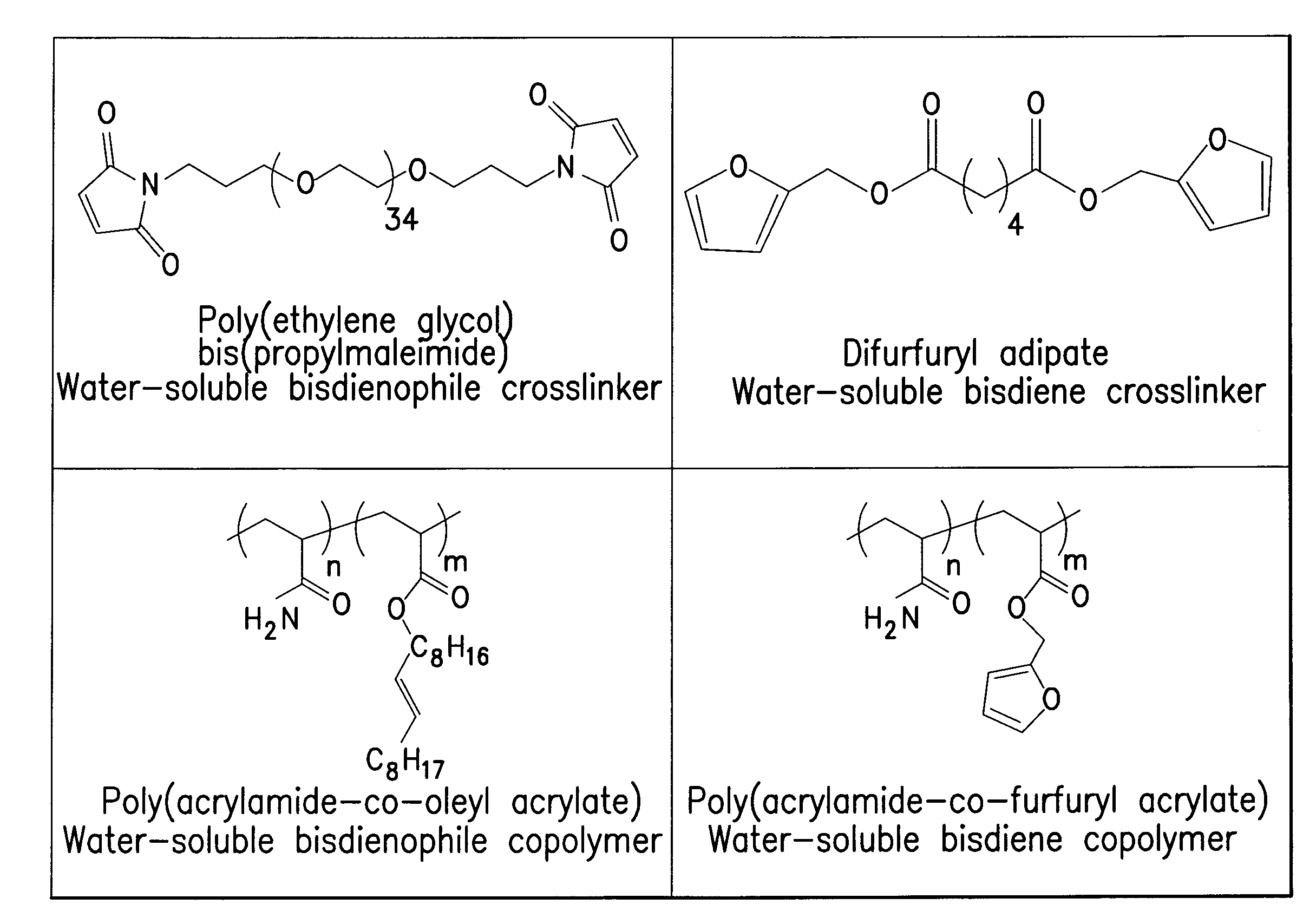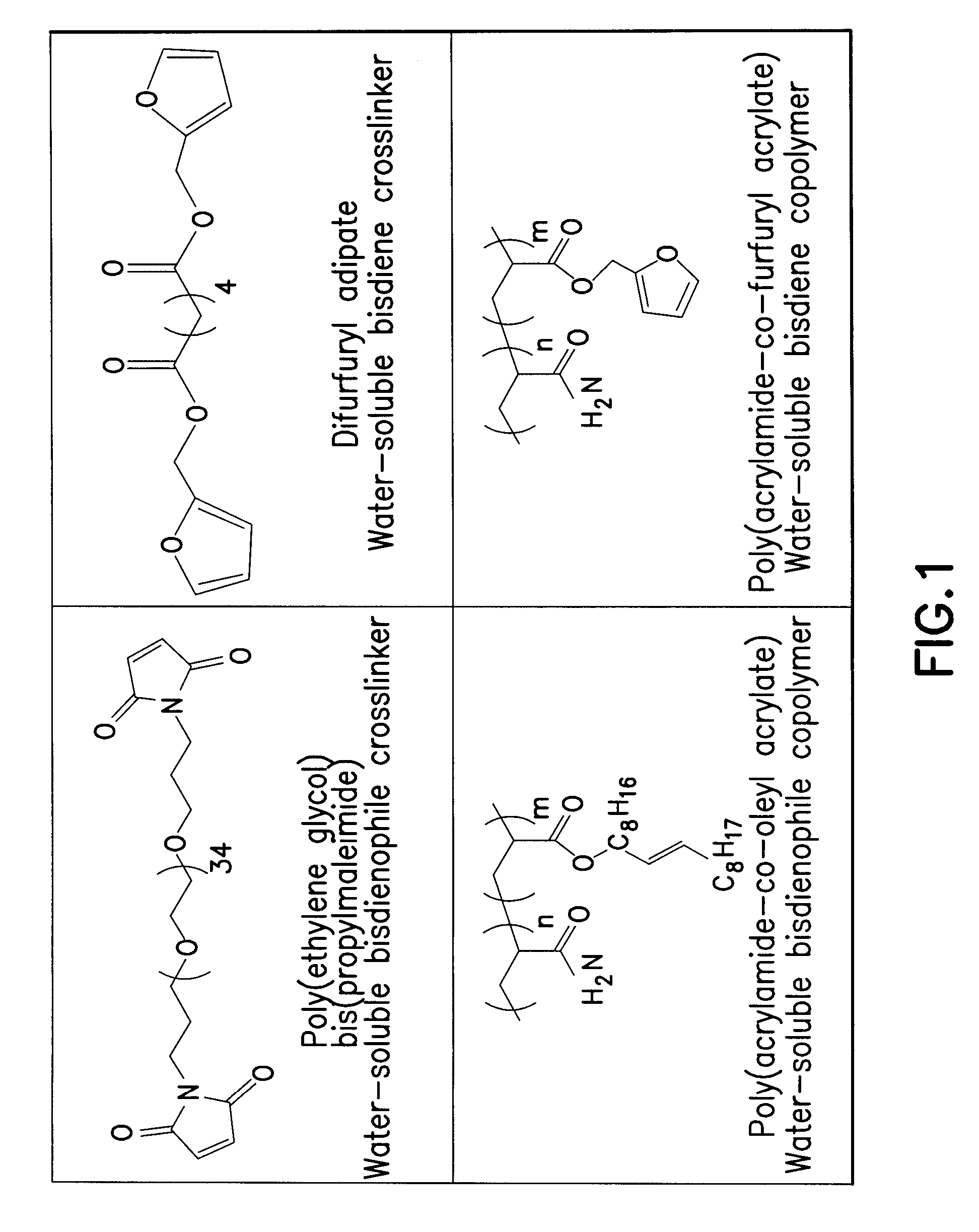Reversible polymeric gelation for oilfield applications
a polymer gel and oilfield technology, applied in the direction of sealing/packing, cabinetry, borehole/well accessories, etc., can solve the problem that the copolymer is prone to thermal decomposition, and achieve the effect of reducing the viscosity of the aforementioned gel and little or no formation damag
- Summary
- Abstract
- Description
- Claims
- Application Information
AI Technical Summary
Benefits of technology
Problems solved by technology
Method used
Image
Examples
example 1
Synthesis of Furfuryl Acrylate
[0123]
[0124]Furfuryl alcohol (5.3 mL, 1 eq.) was dissolved in THF (100 mL) in a dry, round bottomed flask and stirred with triethylamine (10.7 mL, 1.25 eq.). The solution was cooled to 0° C. and acryloyl chloride (5 mL, 1 eq.) was added dropwise. The mixture was stirred for 3 h at 20° C. The reaction was worked up by diluting with dichloromethane (50 mL) and filtered through a celite plug to remove the triethylammonium chloride, and the solvent was removed under vacuum. The residue was purified by silica column chromatography using tert-butylmethyl ether-hexane (1:7) (furfuryl acrylate Rf 0.51) to give an oil (7.9 g 84.5% yield). IR (cm−1): 1728 (C═O st), 3147, 3124 (═C—H st), 810, 748 (C—H δ, furan ring). 1H NMR (CDCl3, 300 MHz): δ 6.39 (dd, 1H, H-1A, J1A,1B=17.3 Hz, J1A,2=1.47 Hz), 6.10 (dd, 1H, H-1B J1B,2=10.41 Hz), 5.79 (dd, 1H, H-2), 5.10 (s, 2H, CH2) ppm. Furan ring: 6.40 (bd, 1H, H-3′, J3′,4′=3.2 Hz), 6.33 (dd, 1H, H-4′, J4′,5′=1.9 Hz), 7.39 (m, ...
example 2
Synthesis of Furfuryl Isobutyrate
[0125]
[0126]Furfuryl alcohol (5 mL, 1 eq.) was dissolved in THF (20 mL) in a dry, round bottomed flask and stirred with triethylamine (10 mL, 1.25 eq.). The solution was cooled to 5° C. and isobutyryl chloride (60.1 mL, 1.0 eq.) was added dropwise. The mixture was stirred for 2 h at 20° C. The reaction was worked up by diluting with dichloromethane (30 mL) and filtered through a celite plug to remove the triethylammonium chloride, and the solvent was removed under vacuum. The residue was purified by silica column chromatography using tert-butylmethyl ether-hexane (1:5) (Rf 0.54) to give an oil (8.5 g 87.5% yield). IR (cm−1): 1737 (C═O st), 3145, 3124 (═C—H st), 816, 745 (C—H δ, furan ring). 1H NMR (CDCl3, 300 MHz): δ 2.57 (sept, 1H, C—H(CH3)2, J=6.9 Hz), 1.17 (d, 6H, CH(CH3)2, J=6.9 Hz), 5.06 (s, 2H, CH2O) ppm. Furan ring: 6.39 (bd, 1H, H-3′, J3′,4′=3.3 Hz), 6.35 (dd, 1H, H-4′, J4′,5′=1.8 Hz), 7.41 (m, 1H, H-5′) ppm. 13C NMR (CDCl3, 75 MHz): δ 176.7 ...
example 3
Synthesis of Poly(acrylamide-co-furfuryl acrylate)
[0127]
[0128]For a typical procedure acrylamide (4.5 g, 95 mol %) was dissolved in H2O (60 mL) in a 250 ml, round bottomed flask. The second monomer (furfuryl acrylate, 0.5 g, 5 mol %) was dissolved in ethanol (6 mL) and added. The solution for degassed by 10 cycles of vacuum / argon at 30° C., and 2,2′-azobis(2-methylpropionitrile) initiator (4 mg) was added. The reaction was left stirring at 70° C. for 3.5 h. Acetone (200 mL) was added to the copolymer solution and the precipitation of the copolymer was promoted by the addition of sodium dodecyl sulfate (0.5 g). The copolymer was redissolved in H2O (60 mL) and the precipitation procedure was repeated until the copolymer was pure (3.9 g, 78% yield). The copolymer was freeze dried and stored in a dessicator. Elemental Analysis: Copolymer 1 theoretical: C, 44.93; H, 7.45; N, 15.18; poly(acrylamide95%-furfuryl acrylate5%), experimental: C, 44.72; H, 7.292; N, 15.03; poly(acrylamide93%-fur...
PUM
| Property | Measurement | Unit |
|---|---|---|
| Temperature | aaaaa | aaaaa |
| Temperature | aaaaa | aaaaa |
| Viscosity | aaaaa | aaaaa |
Abstract
Description
Claims
Application Information
 Login to View More
Login to View More - R&D
- Intellectual Property
- Life Sciences
- Materials
- Tech Scout
- Unparalleled Data Quality
- Higher Quality Content
- 60% Fewer Hallucinations
Browse by: Latest US Patents, China's latest patents, Technical Efficacy Thesaurus, Application Domain, Technology Topic, Popular Technical Reports.
© 2025 PatSnap. All rights reserved.Legal|Privacy policy|Modern Slavery Act Transparency Statement|Sitemap|About US| Contact US: help@patsnap.com



